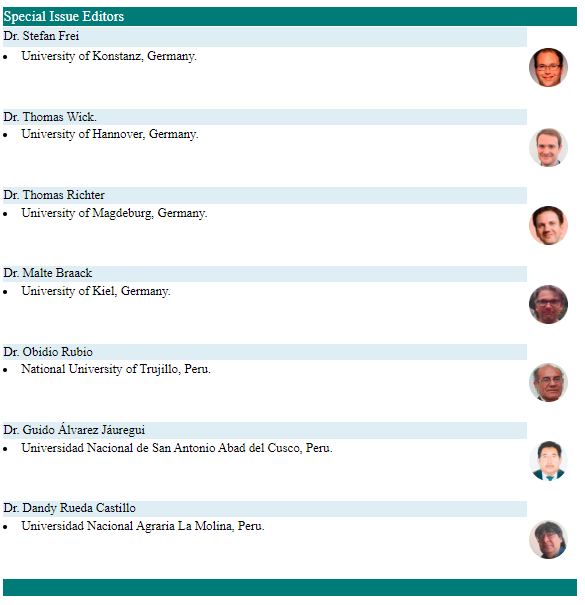The SIRD epidemiological model using Caputo fractional derivatives applied to study the spread of the COVID-19 in the Peruvian region of Tacna
DOI:
https://doi.org/10.17268/sel.mat.2024.02.03Palabras clave:
Fractional ordinary differential equations, Fractional derivatives and integrals, Caputo fractional derivative, SIRD model for infectious diseasesResumen
Mathematical models are widely used to study the spreading dynamics of infectious diseases. In particular, the “Susceptibles-Infecteds-Recovereds-Deceases”(SIRD) model provides a framework that can be adapted to describe the core spreading dynamics of several human and wildlife infectious diseases. The present work uses a SIRD model using Caputo fractional derivative. In this investigation, the existence and uniqueness of solutions for the model were established. Numerical solutions were obtained using the Adams-Bashforth method. To illustrate the model’s utility, we made forecasts for the spread of the virus SARS-Cov-2 in the region of Tacna in Perú.
It is well known that these models can help to forecast the number of infected people, understand the disease dynamics and evaluate potential control strategies.
Citas
Benedictow OJ. The complete history of the Black Death. Woodbridge: Boydell & Brewer; 2021.
Kermack WO, McKendrick AG. A contribution to the mathematical theory of epidemics. Proceedings of the Royal Society of London Series A, Containing papers of a mathematical and physical character. 1927;115(772):700 -721.
Coayla-Teran EA. A COVID-19 time-dependent SIRD model using functional differential equations. International Journal of Ecology and Development. 2021;36(3):1-11.
Nisar KS, Ahmad S, Ullah A, Shah K, Alrabaiah H, Arfan M. Mathematical analysis of SIRD
model of COVID-19 with Caputo fractional derivative based on real data. Results in Physics.
;21:103772. Available from: https://www.sciencedirect.com/science/article/
pii/S2211379720321823.
Rezapour S, Mohammadi H, Samei ME. SEIR epidemic model for COVID-19 transmission by Caputo derivative of fractional order. Advances in difference equations. 2020;2020:1-19.
Alshomrani AS, Ullah MZ, Baleanu D. Caputo SIR model for COVID-19 under optimized fractional order. Advances in Difference Equations. 2021;2021(1):185.
Kilbas AA, Srivastava HM, Trujillo JJ. Theory and applications of fractional differential equations. vol. 204. Amsterdam: Elsevier; 2006.
Vargas-Pichón HB, Coayla-Teran EA, Tejada-Vásquez E. The SIRD epidemiological model applied to spread of the COVID-19 in the Peruvian region of Tacna. Selecciones Matemáticas. 2022;9(01):137 -144.
Vergara-Moreno E, et al. Modelo básico epidemiológico SIR para el COVID-19: caso las Regiones del Perú. Selecciones Matemáticas. 2020;7(01):151 -161.
DIRESA. Health directory of Tacna region in Peru;. May 2023. Available from: https://www.facebook.com/drstacna.
INEI. National Institute of Statistics and Computing of Peru;. June 2020. Available from:
https://www.inei.gob.pe/media/MenuRecursivo/publicacionesdigitales/Est/Lib1715/libro.pdf.
Brauer F, Castillo-Chavez C. Mathematical models in population biology and epidemiology. vol. 2. New York: Springer; 2012.
Descargas
Publicado
Cómo citar
Número
Sección
Licencia

Esta obra está bajo una licencia internacional Creative Commons Atribución 4.0.
Los autores/as que publiquen en esta revista aceptan las siguientes condiciones:
- Los autores/as conservan los derechos de autor y ceden a la revista el derecho de la primera publicación, con el trabajo registrado con la licencia de atribución de Creative CommonsAtribución 4.0 Internacional (CC BY 4.0) , que permite a terceros utilizar lo publicado siempre que mencionen la autoría del trabajo y a la primera publicación en esta revista.
- Los autores/as pueden realizar otros acuerdos contractuales independientes y adicionales para la distribución no exclusiva de la versión del artículo publicado en esta revista (p. ej., incluirlo en un repositorio institucional o publicarlo en un libro) siempre que indiquen claramente que el trabajo se publicó por primera vez en esta revista.
- Se permite y recomienda a los autores/as a publicar su trabajo en Internet (por ejemplo en páginas institucionales o personales) antes y durante el proceso de revisión y publicación, ya que puede conducir a intercambios productivos y a una mayor y más rápida difusión del trabajo publicado(Consultar: efecto del acceso abierto).













